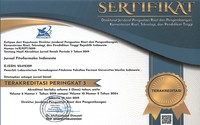Daun Cempaka Kuning (Michelia champaca Linn) sebagai Kandidat Penghambat Enzim α-glukosidase secara In Silico
Abstract
Keywords
Full Text:
PDF (Bahasa Indonesia)References
Aditya, W.A. and Ramadhania, Z.M. (2019) ‘Artikel Ulasan: Kandungan dan Aktivitas Farmakologi Tanaman Cempaka Kuning (Michelia Champaca Linn.)’, Farmaka, 16(3), pp. 10–19.
Baig, M.H. et al. (2014) ‘Drug Discovery and In Silico Techniques: A Mini-Review’, Enzyme Engineering, 3(2), pp. 1–3. Available at: https://doi.org/10.4172/2329-6674.1000123.
Budianto, N.E.W. and Hairullah, H. (2017) ‘Perbedaan Efektivitas Acarbose dengan Ekstrak Etanol Kulit Terong Ungu (Solanum melongena L) terhadap Penurunan Kadar Gula Darah Tikus Putih (Rattus norvegicus) yang Diinduksi Sukrosa’, Jurnal Ilmiah Kedokteran Wijaya Kusuma, 6(2), pp. 14–20.
Cole, J.C. et al. (2005) ‘Comparing Protein–Ligand Docking Programs is Difficult’, Protein, 60(3), pp. 325–332. Available at: https://doi.org/10.1002/prot.20497.
Fikry, M.A. (2014) Studi Penambatan Molekul Senyawa-Senyawa Flavonoid Dari Buah Mengkudu (Morinda citrifolia L) Pada Peroxisome Proliferator-Activated Receptor Gamma (PPARɣ). UIN Syarif Hidayatulla Jakarta.
Geetha, K.N., Jeyaprakash, K. and Nagaraja, Y.P. (2011) ‘A Preliminary Pharmacognostical Study on Leaves and Flowers of Michelia champaca L. Magnoliaceae’, Journal of Applied and Natural Science, 3(2), pp. 228–231. Available at: https://doi.org/10.31018/jans.v3i2.184.
Hamidu, L., Simanjuntak, P. and Dewi, R.T. (2020) ‘Potensi Ekstrak Buah Buni (Antidesma bunius (L) Spreng) Sebagai Inhibitor Enzim α-Glukosidase’, Jurnal Fitofarmaka Indonesia, 7(1), pp. 27–30. Available at: https://doi.org/10.33096/jffi.v7i1.598.
Hossain, Md.M. et al. (2009) ‘Antioxidant, Analgesic and Cytotoxic Activity of Michelia champaca Linn. Leaf’, Stamford Journal of Pharmaceutical Sciences, 2(2), pp. 1–7.
International Diabetes Federation (2021) IDF Diabetes Atlas. 10th edn. Brussels, Belgium: International Diabetes Federation.
Karthikeyan V and Br, B. (2016) ‘Pharmacognostical, Phyto-Physicochemical Profile of the Leaves of Michelia champaca Linn’, Internasional Journal Of Pharmacy & Pharmaceutical Research.Human, 7(1), pp. 331–344.
Kashtoh, H. and Baek, K.H. (2022) ‘Recent Updates on Phytoconstituent Alpha-Glucosidase Inhibitors: An Approach towards the Treatment of Type Two Diabetes’, Plants, 11(20), pp. 1–25. Available at: https://doi.org/10.3390/plants11202722.
Leach, A.R., Shoichet, B.K. and Peishoff, C.E. (2006) ‘Prediction of protein-ligand interactions. Docking and scoring: Successes and gaps’, Journal of Medicinal Chemistry, 49(20), pp. 5851–5855. Available at: https://doi.org/10.1021/jm060999m.
Li, H. et al. (2015) ‘Improving AutoDock Vina Using Random Forest: The Growing Accuracy of Binding Affinity Prediction by the Effective Exploitation of Larger Data Sets’, Molecular Informatic, 34(2–3), pp. 115–126. Available at: https://doi.org/https://doi.org/10.1002/minf.201400132.
Masaenah, E. et al. (2021) ‘Antidiabetic Activity and Acute Toxicity of Combined Extract of Andrographis paniculata, Syzygium cumini, and Caesalpinia sappan’, Heliyon, 7(12), p. e08561. Available at: https://doi.org/10.1016/j.heliyon.2021.e08561.
Morris, G.M. et al. (2012) AutoDock Version 4.2: Automated Docking of Flexible Ligands to Flexible Receptors. La Jolla, CA USA: The Scripps Research Institute.
Naik, R.R., Munipally, P.K. and Nagaraju, T. (2017) ‘Andrographolide Reorganise Hyperglycaemia and Distorted Antioxidant Profile in Streptozotocin-Induced Diabetic Rats’, Cardiovasc Hematol Agents Med Chem, Oct 26. Available at: https://doi.org/10.2174/1871525715666171026115248.
Nugroho, A.E. et al. (2012) ‘Antidiabetic and Antihiperlipidemic Effect of Andrographis paniculata (Burm. f.) Nees and Andrographolide in High-Fructose-fat-fed Rats’, Indian Journal of Pharmacology, 44(3), pp. 377–381.
Rahmi, I.A., Jufri, M. and Mun’im, A. (2020) ‘Extraction of quercetin from nothopanax scutellarium leaves via ionic liquid-based microwave-assisted extraction’, Pharmacognosy Journal, 12(6), pp. 1512–1517. Available at: https://doi.org/10.5530/pj.2020.12.207.
Ruwali, P., Adhikari, M. and Sharma, S. (2019) ‘Phytochemical and Antioxidant Properties of Various Extracts of Michelia champaca Leaves’, International Journal of Pharmacy and Pharmaceutical Sciences, 11(5), pp. 56–61. Available at: https://doi.org/10.22159/ijpps.2019v11i5.31745.
Sim, L. et al. (2008) ‘Human Intestinal Maltase–Glucoamylase: Crystal Structure of the N-Terminal Catalytic Subunit and Basis of Inhibition and Substrate Specificity’, Journal of Molecular Biology, 375(3), pp. 782–792. Available at: https://doi.org/10.1016/j.jmb.2007.10.069.
Sinan-Tokalı, F. (2022) ‘Novel Benzoic Acid Derivatives Bearing Quinazolin-4(3H)-one Ring: Synthesis, Characterization, and Inhibition Effects on α-Glucosidase and α-Amylase’, ChemistrySelect, 7(48), p. e202204019. Available at: https://doi.org/https://doi.org/10.1002/slct.202204019.
Su, C.H., Hsu, C.H. and Ng, L.T. (2013) ‘Inhibitory Potential of Fatty Acids on Key Enzymes Related to Type 2 Diabetes’, BioFactors, 39(4), pp. 415–421. Available at: https://doi.org/10.1002/biof.1082.
Trott, O. and Olson, A.J. (2010) ‘Autodock Vina: Improving The Speed And Accuracy Of Docking With A New Scoring Function, Efficient Optimization And Multithreading’, Journal of Computational Chemistry, 31, p. ) 455-461.
Wei, L.S. et al. (2011) ‘Characterization of Antimicrobial, Antioxidant, Anticancer Property and Chemical Composition of Michelia champaca Seed and Flower Extracts’, Stamford Journal of Pharmaceutical Sciences, 4(1), pp. 19–24. Available at: https://doi.org/10.3329/sjps.v4i1.8862.
Yamamoto, K. et al. (2010) ‘Crystal Structures of Isomaltase from Saccharomyces cerevisiae and in Complex with Its Competitive Inhibitor Maltose’, FEBS Journal, 277(20), pp. 4205–4214. Available at: https://doi.org/10.1111/j.1742-4658.2010.07810.x.
Yang, J.Y. et al. (2017) ‘Inhibitory Potential of Constituents from Osmanthus fragrans and Structural Analogues Against Advanced Glycation End Products, α-Amylase, α-Glucosidase, and Oxidative Stress’, Scientific Reports, 7(October 2016), pp. 1–9. Available at: https://doi.org/10.1038/srep45746.
Yuniarto, A. and Selifiana, N. (2018) ‘Aktivitas Inhibisi Enzim Alfa-glukosidase dari Ekstrak Rimpang Bangle (Zingiber cassumunar Roxb.) secara In vitro’, MPI (Media Pharmaceutica Indonesiana), 2(1), pp. 22–25. Available at: https://doi.org/10.24123/mpi.v2i1.1299.
DOI: https://doi.org/10.33096/jffi.v11i1.1183
Copyright (c) 2024 Riyanti Amalia; Made laksmi Meiliana; La Hamidu

This work is licensed under a Creative Commons Attribution-ShareAlike 4.0 International License.
Indexed by:
ISSN: 2356-0398 | e-ISSN: 2541-2329
Editor's Address:
Third Floor Pharmacognosy-phytochemistry laboratory building, Urip Sumoharjo road km. 5 Campus II UMI, Makassar, South Sulawesi, Indonesia
Phone: +6281524045514
Fax: +62411425619
E-mail: editorjfi@umi.ac.id

















.jpg)

